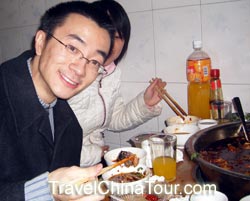There's an old Chinese adage that says: "People view
food as the most important". That pretty much sums
up my view on food as well. I love to eat all types of food
and cuisine, and I especially enjoy the hot and spicy food
of the Szechuan province in China.
China's food and cuisine has had a long history. The five
flavors of spicy, sweet, bitter, sour, and salty has been
used in Chinese cooking over 3,000 years ago. Today, traditional
Chinese food ranks among the worlds best and most popular.
Authentic Chinese cuisine focus on 3 key aspects: taste,
color (display), and fragrance, and chinese cooking is very
particular about cutting style and cooking temperature.
8 Regional Chinese Cuisine & Chinese
Food
Different regions in China offer vastly different styles
of cooking and cuisine. There are estimated over 5,000 cooking
styles in China. The 8 main regional Chinese cuisine are:
- Szechuan Cuisine
- Guangdong (Cantonese) Cuisine
- Shandong Cuisine
- Huaiyang Cuisine
- Fujian Cuisine
- Hunan Cuisine
- Zhejiang Cuisine
- Anhui Cuisine
We'll briefly explain each style below.
China Szechuan Cooking
I am originally born in Szehuan province. (note: there
are several ways "Szechuan" is spelt including:
Szechuan, Sichuan, and Szechwan, so either spelling is fine)
I can't get enough of the enormous varieties of spicy and
non spicy Sichuan food.
Szechwan cooking makes heavy use of dried and fresh red
chilies, Szechuan pepper, ginger, and garlic, and is most
well known for its Spicy and Numbing taste. Authentic Sichuan
peppercorn has a unique effect of making your tongue and
mouth feel numb - probably quite strange to someone who's
never tried it. It's said that a person who has never tried
Szechuan cuisine has never reached China.
Food is very much the single most important aspect of enjoying
life in Szechuan. Everyday life revolved around food. Fresh
meats and vegetables are bought at the market everyday unlike
the weekly grocery shopping habits we have here in North
America.
One of the most popular Szechuan cuisine is its famous
hot pots (Huo Guo). It has spread all over China, and gaining
popularity in the world as well; however, I have to say
that unless you travel to Szechuan China yourself and taste
the authentic hotspot there, then you really haven't tried
the real Szechuan hot pot. I've tried all types of "hot
pot" claiming to be "authentic Sichuan hot pot",
but nothing ever comes close to the real thing.
The most famous hot pot in Szechuan would have to be Chongqing
hot pot. It has spread all over China, and to various parts
of the world. There are also different specialties of Sichuan
hot pot making highlight of a certain type of food, such
as duck hot pot, rabbit hot pot, eel hot pot, wild mushroom
hot pot, fish hot pot, fish head hot pot, frog hot pot and
more. Depending on what you feel like that day, there's
a choice that will satisfy your taste buds.

I am with my family in Neijiang Szechuan, eating a rabbit
hot pot.

Here, I am in Chengdu with my cousins and wife eating the
locally famous frog hot pot.
Of course, hot pot is not the only cooking style in Sichuan
- steaming, smoking, stewing, boiling, stir frying are all
used widely in szechuan cooking.
Shandong China Food
Shangdong cooking is well known for its light, non greasy
cooking style. Extra effort is made to preserve and emphasize
the original flavor and aroma of the cooking ingredients.
Shallots and garlic are commonly used in Shangdong cuisine.
Shangdong cuisine is also known for its soups. Light soups
are clear and fresh, and creamy soups are thick and strong
in flavor. One type of light soup, made with swallow's nest
is often served as the first major course at banquets -
unlike other Chinese soups which always come at the end
of a meal. Another well known specialty of Shangdong cooking
is a dish called Sweet and Sour Huanghe Carp (yellow river
carp). Read about the remaining six regional Chinese
cuisine in part 2
|